A kitchen backsplash serves both functional and aesthetic purposes, protecting walls from splashes and spills while contributing to the overall design of the kitchen. Green kitchen backsplashes are increasingly popular, offering a versatile and refreshing look that can range from soothing and serene to bold and vibrant. Here, we explore various green kitchen backsplash ideas, materials, styles, and tips to help you create a beautiful and unique kitchen space.
Benefits of a Green Kitchen Backsplash
Enhances Mood and Ambiance
A green backsplash can significantly influence the mood of your kitchen. Green is often associated with nature, tranquility, and renewal, making it an excellent choice for creating a calming and welcoming environment. Whether you prefer a soft sage green for a peaceful ambiance or a bright emerald to energize the space, green can set the perfect tone for your kitchen.

Complements Various Color Schemes
Green is a versatile color that pairs well with a wide range of other hues. It can complement neutral tones like white, beige, and gray, as well as bolder colors such as navy, black, and gold. This adaptability makes green an excellent choice for any kitchen design, whether you’re going for a modern, traditional, or eclectic look.
Adds a Touch of Nature
Incorporating green into your kitchen backsplash can bring a touch of the outdoors inside, which can be particularly refreshing in urban settings. Green tiles or panels can mimic the look of leafy plants, grass, or other natural elements, helping to create a more organic and earthy kitchen space.
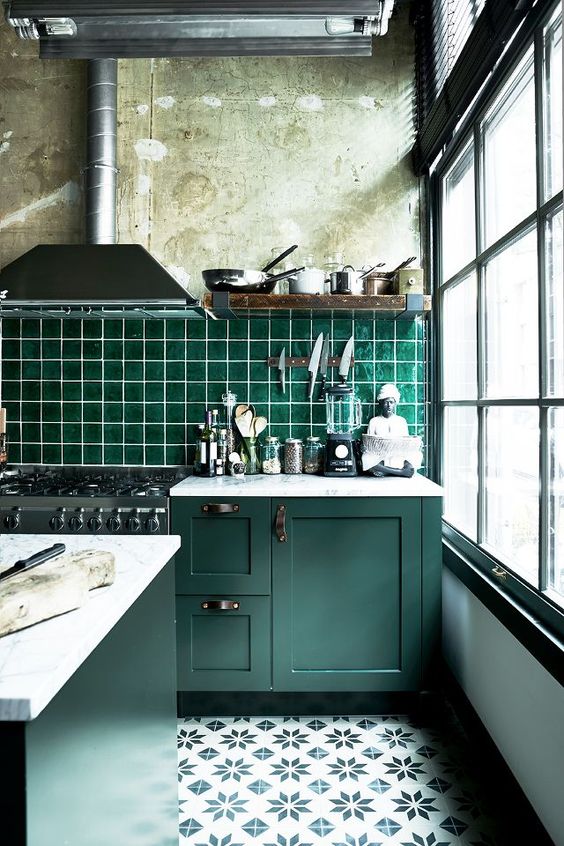
Reflects Light and Brightens the Space
Depending on the shade and finish, green backsplashes can reflect light and make your kitchen appear brighter and more spacious. Glossy tiles, for instance, can bounce light around the room, enhancing the overall luminosity and making the kitchen feel more open and airy.
Offers Design Flexibility
From classic subway tiles to intricate mosaic patterns, green backsplashes come in a variety of styles, shapes, and materials. This flexibility allows you to find the perfect design that fits your taste and complements the rest of your kitchen decor. You can mix and match different shades of green or combine green tiles with other colors to create a unique and personalized look.
Easy Maintenance and Durability
Green backsplashes, especially those made from tiles or glass, are typically easy to clean and maintain. They are resistant to stains, moisture, and heat, making them a practical choice for the kitchen. With proper care, a green backsplash can maintain its beauty and functionality for years.

Popular Green Backsplash Materials
Ceramic and Porcelain Tiles
Ceramic and porcelain tiles are among the most popular materials for kitchen backsplashes. They come in a wide range of green shades and finishes, from matte to glossy. These tiles are durable, easy to clean, and relatively affordable, making them an excellent choice for a functional and stylish backsplash.
Glass Tiles
Glass tiles offer a sleek and modern look, with a glossy finish that reflects light beautifully. They are available in various shades of green, from light mint to deep forest. Glass tiles are non-porous, making them resistant to stains and moisture, and they are easy to wipe clean. They can be used alone or mixed with other materials for a unique design.
Natural Stone
For a more organic and textured look, natural stone tiles such as marble, granite, or slate can be an excellent choice. Green stones, like serpentine or certain types of marble, add a luxurious and earthy touch to your kitchen. While natural stone requires more maintenance to keep it looking its best, its unique veining and patterns can create a stunning focal point.

Metal Tiles
Metal tiles, including stainless steel or copper with green patina, offer a contemporary and industrial look. These tiles are highly durable and easy to clean, making them a practical choice for busy kitchens. The green patina can add a unique and artistic element to the backsplash, creating a striking contrast with other materials.
Mosaic Tiles
Mosaic tiles allow for intricate and detailed designs, making them perfect for creating a visually interesting backsplash. They can be made from various materials, including glass, ceramic, or stone, and come in an array of green shades. Mosaic backsplashes can be customized to create patterns, images, or gradients, adding a personal touch to your kitchen.
Recycled and Eco-friendly Materials
For those looking to create a sustainable kitchen, recycled glass or eco-friendly tiles made from reclaimed materials can be an excellent option. These tiles are available in various green shades and can help reduce environmental impact. Using recycled materials not only adds a unique aesthetic but also promotes sustainability.
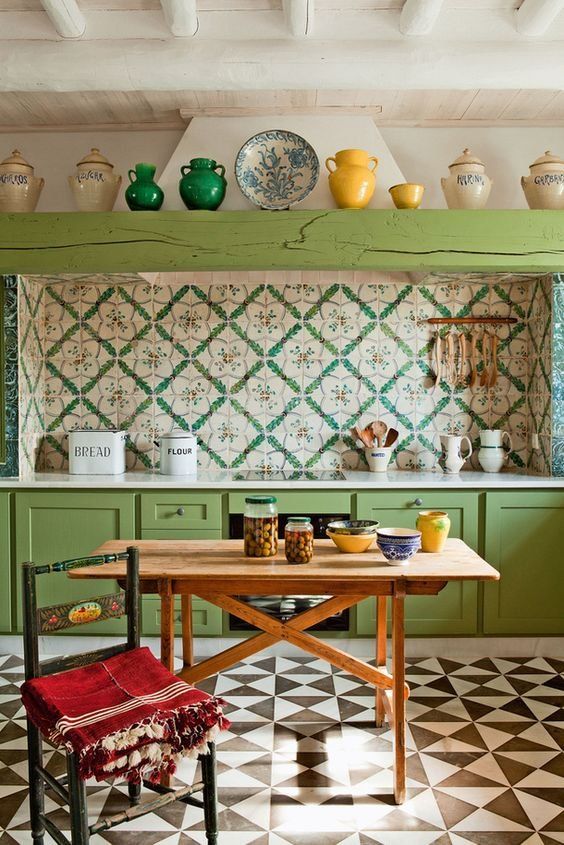
Styles and Patterns for Green Backsplashes
Subway Tiles
Subway tiles are a classic and timeless choice for kitchen backsplashes. Green subway tiles can be arranged in various patterns, such as the traditional horizontal stack, herringbone, or vertical stack, to create different looks. The clean lines and uniform shape of subway tiles make them suitable for both modern and traditional kitchens.
Herringbone and Chevron Patterns
Herringbone and chevron patterns add a dynamic and sophisticated touch to any backsplash. Using green tiles in these patterns can create a visually striking and elegant look. The diagonal arrangement of the tiles adds movement and interest, making the backsplash a focal point in the kitchen.
Moroccan and Geometric Designs
For a more intricate and decorative look, Moroccan and geometric tile designs can be a fantastic choice. These tiles often feature elaborate patterns and shapes, adding a touch of exotic flair to the kitchen. Green Moroccan or geometric tiles can create a unique and artistic backsplash that stands out.
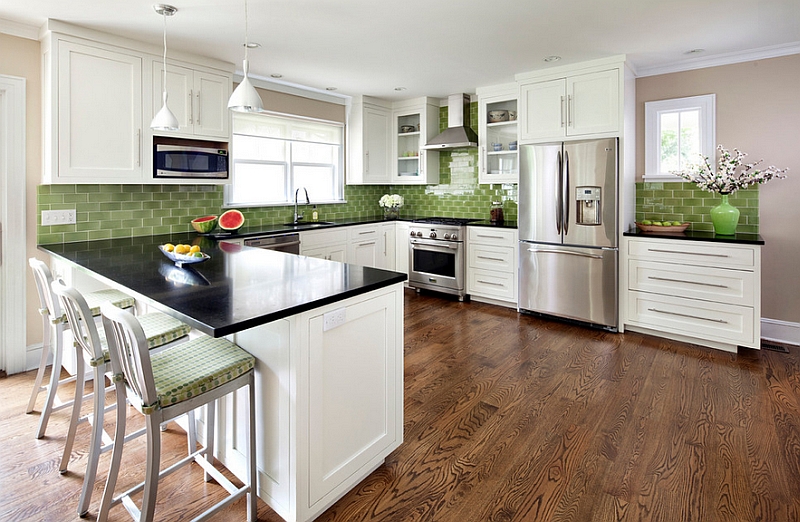
Hexagon and Octagon Tiles
Hexagon and octagon tiles offer a modern and geometric look that can add depth and interest to the backsplash. These tiles come in various sizes and shades of green, allowing you to create a customized and contemporary design. The honeycomb pattern of hexagon tiles can add texture and visual appeal to the kitchen.
Brick and Rustic Styles
Brick-style tiles or rustic stone tiles can add a warm and earthy feel to the kitchen. Green brick tiles can mimic the look of a vintage brick wall, adding character and charm to the space. Rustic stone tiles, with their natural texture and color variations, create a cozy and inviting atmosphere.
Custom and Artistic Murals
For a truly unique and personalized backsplash, consider commissioning a custom mural or creating an artistic design using green tiles. This can be a focal point in the kitchen, reflecting your personal style and taste. Whether it’s a nature scene, abstract design, or a replication of a famous artwork, a custom mural can make your kitchen truly one-of-a-kind.
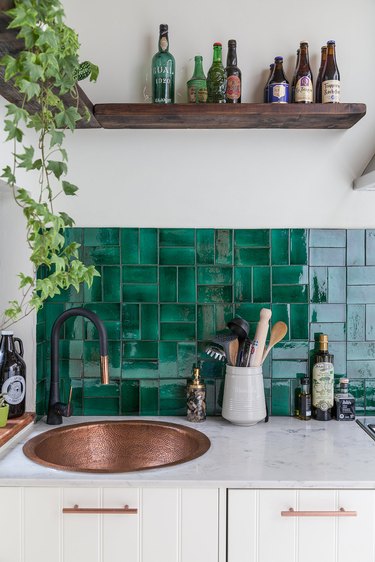
Tips for Choosing the Right Shade of Green
Consider the Overall Color Scheme
When selecting the shade of green for your backsplash, consider the overall color scheme of your kitchen. Think about the colors of your cabinets, countertops, and appliances, and choose a green that complements or contrasts them effectively. For a cohesive look, match the shade of green with other elements in the kitchen.
Assess the Lighting
Lighting plays a crucial role in how the color appears in your kitchen. Natural light can enhance the vibrancy of the green, while artificial lighting can alter its tone. Test different shades of green under various lighting conditions to see how they look at different times of the day.
Match with Cabinetry and Countertops
The shade of green you choose should harmonize with your cabinetry and countertops. For example, a soft pastel green can complement white or light-colored cabinets, while a deep emerald green can pair well with dark wood or black cabinets. Consider the material and finish of your countertops when selecting the shade of green.

Decide on the Desired Mood
Different shades of green can evoke different moods. Lighter greens, like mint or sage, can create a calm and serene atmosphere, while darker greens, like forest or olive, can add depth and sophistication. Decide on the mood you want to create in your kitchen and choose a shade that aligns with that vision.
Test Samples Before Committing
Before making a final decision, test samples of the green tiles or materials you are considering. Place the samples on the wall and observe how they look with the rest of your kitchen decor. This will help you visualize the final result and ensure you are happy with your choice.
Think About Longevity
While bold and trendy shades of green can be appealing, consider how the color will age over time. Choose a shade that you will still love in the years to come, and that will not easily go out of style. Neutral or classic shades of green can offer timeless appeal.
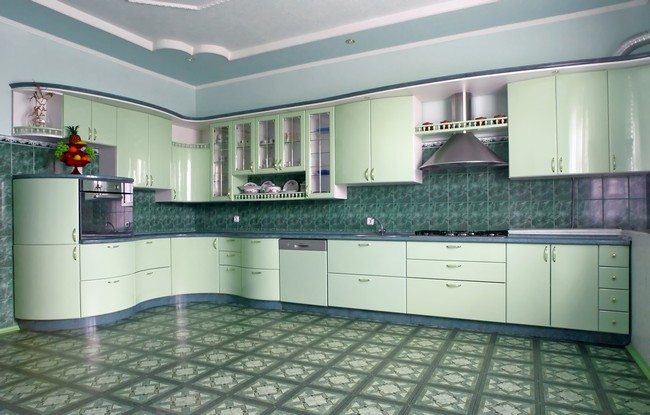
Installation and Maintenance Tips
Proper Surface Preparation
Before installing your green backsplash, ensure the surface is properly prepared. Clean the wall thoroughly to remove any grease, dirt, or residue. Repair any cracks or holes and ensure the surface is smooth and even. Proper preparation will ensure the tiles adhere well and the installation lasts.
Use Quality Adhesives and Grout
Invest in high-quality adhesives and grout to ensure a durable and long-lasting installation. Choose a grout color that complements the green tiles and enhances the overall design. Epoxy grout, while more expensive, offers superior durability and resistance to stains and moisture.
Consider Professional Installation
While DIY installation can be cost-effective, consider hiring a professional for a flawless finish, especially if you are using intricate patterns or expensive materials. Professional installers have the expertise and tools to ensure the backsplash is installed correctly and look its best.
Regular Cleaning and Maintenance
To keep your green backsplash looking its best, clean it regularly with a mild detergent and a soft cloth or sponge. Avoid using abrasive cleaners or scrubbing pads that can damage the tiles. For natural stone backsplashes, use a stone-specific cleaner and reseal the tiles periodically to protect against stains and moisture.
Address Grout Lines
Grout lines can become dirty and discolored over time. Clean the grout lines regularly with a grout cleaner or a mixture of baking soda and water. For stubborn stains, a grout brush can help scrub away dirt. Sealing the grout can also help prevent staining and make cleaning easier.
Handle Repairs Promptly
If you notice any cracks or damage to your backsplash, address them promptly to prevent further issues. Replace broken tiles and re-grout as needed to maintain the integrity and appearance of your backsplash. Regular maintenance and timely repairs will ensure your green backsplash remains beautiful and functional for years.

Common Mistakes to Avoid
Choosing the Wrong Shade
One of the most common mistakes is selecting a shade of green that clashes with the rest of your kitchen decor. To avoid this, test different shades under various lighting conditions and consider how they will look with your cabinetry, countertops, and appliances.
Ignoring the Overall Color Scheme
Ignoring the overall color scheme of your kitchen can result in a mismatched and chaotic look. Ensure the shade of green you choose complements or contrasts effectively with the existing colors in your kitchen. Consider consulting with a design professional if you are unsure.
Skipping Surface Preparation
Skipping proper surface preparation can lead to issues with tile adhesion and longevity. Always clean and repair the wall surface before installation to ensure a smooth and durable finish. This step is crucial for the tiles to adhere properly and to avoid future problems.
Using Low-Quality Materials
Using low-quality tiles, adhesives, or grout can result in a subpar installation that may not last. Invest in high-quality materials to ensure a durable and attractive backsplash. Quality materials are worth the investment for long-term satisfaction and durability.
Inadequate Grout Sealing
Failing to seal the grout can lead to stains and moisture damage. Always seal the grout after installation and reapply the sealant periodically to protect it. Sealing the grout helps maintain its appearance and prevents common issues like staining and mold growth.
Neglecting Maintenance
Neglecting regular cleaning and maintenance can cause your backsplash to lose its luster and develop stains or damage. Clean the tiles and grout regularly, address any repairs promptly, and reseal natural stone tiles as needed. Consistent maintenance is key to preserving the beauty and functionality of your backsplash.
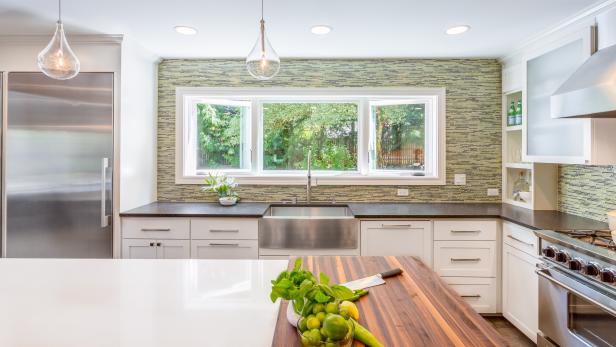
What are the best materials for a green kitchen backsplash?
The best materials for a green kitchen backsplash include ceramic and porcelain tiles, glass tiles, natural stone, metal tiles, mosaic tiles, and recycled or eco-friendly materials. Each material offers unique benefits in terms of durability, maintenance, and aesthetic appeal, allowing you to choose based on your specific needs and preferences.
How do I choose the right shade of green for my backsplash?
To choose the right shade of green, consider the overall color scheme of your kitchen, the lighting conditions, and how the shade complements your cabinetry and countertops. Testing samples and observing them under different lighting conditions can help you make an informed decision. Think about the mood you want to create and opt for a shade that aligns with your vision.
Can I install a green backsplash myself, or should I hire a professional?
While DIY installation is possible, hiring a professional is recommended for a flawless finish, especially if using intricate patterns or expensive materials. Professionals have the expertise and tools to ensure the backsplash is installed correctly, enhancing its durability and appearance. If you have experience and confidence in your DIY skills, you can consider installing simpler designs yourself.

How do I maintain and clean a green kitchen backsplash?
Maintain your green kitchen backsplash by cleaning it regularly with a mild detergent and a soft cloth or sponge. Avoid abrasive cleaners and scrubbing pads. Clean grout lines with a grout cleaner or a mixture of baking soda and water, and reseal the grout periodically to prevent staining. For natural stone backsplashes, use a stone-specific cleaner and reseal the tiles as needed.
What are some design ideas for a green backsplash?
Design ideas for a green backsplash include classic subway tiles, herringbone, and chevron patterns, Moroccan and geometric designs, hexagon and octagon tiles, brick and rustic styles, and custom artistic murals. Each design offers a unique look and can be tailored to fit your kitchen’s style, whether it’s modern, traditional, or eclectic.
How can I ensure my green backsplash will remain stylish over time?
To ensure your green backsplash remains stylish over time, choose a shade and design that offers timeless appeal. Neutral or classic shades of green are less likely to go out of style. Investing in high-quality materials and proper installation will also contribute to the longevity and enduring beauty of your backsplash. Regular maintenance and timely repairs will keep it looking its best for years.

Related Posts:
- Stained Glass Backsplash Kitchen
- Herringbone Kitchen Backsplash Ideas
- Where To Buy Tin Backsplash For Kitchen
- Home Depot Kitchen Backsplash Peel And Stick
- Latest Kitchen Backsplash Trends
- Carrara Marble Kitchen Backsplash
- Latest Trends In Kitchen Backsplash 2022
- Tin Kitchen Backsplash Ideas
- Layered Stone Backsplash Kitchen
- Spanish Kitchen Backsplash